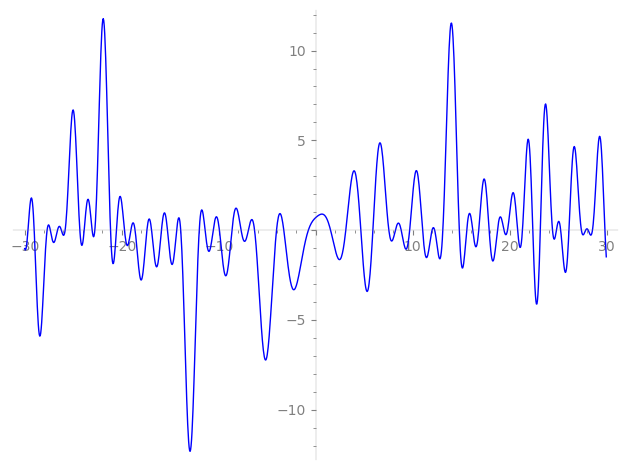| L(s) = 1 | + (−1.33 + 0.462i)2-s + (0.227 + 0.227i)3-s + (1.57 − 1.23i)4-s + (−2.67 + 2.67i)5-s + (−0.409 − 0.198i)6-s − 4.39i·7-s + (−1.52 + 2.37i)8-s − 2.89i·9-s + (2.33 − 4.81i)10-s + (2.02 − 2.02i)11-s + (0.639 + 0.0762i)12-s + (1.66 + 1.66i)13-s + (2.03 + 5.87i)14-s − 1.21·15-s + (0.941 − 3.88i)16-s + 4.30·17-s + ⋯ |
| L(s) = 1 | + (−0.944 + 0.327i)2-s + (0.131 + 0.131i)3-s + (0.785 − 0.618i)4-s + (−1.19 + 1.19i)5-s + (−0.167 − 0.0811i)6-s − 1.66i·7-s + (−0.540 + 0.841i)8-s − 0.965i·9-s + (0.739 − 1.52i)10-s + (0.610 − 0.610i)11-s + (0.184 + 0.0220i)12-s + (0.461 + 0.461i)13-s + (0.543 + 1.57i)14-s − 0.314·15-s + (0.235 − 0.971i)16-s + 1.04·17-s + ⋯ |
Λ(s)=(=(304s/2ΓC(s)L(s)(0.807+0.589i)Λ(2−s)
Λ(s)=(=(304s/2ΓC(s+1/2)L(s)(0.807+0.589i)Λ(1−s)
| Degree: |
2 |
| Conductor: |
304
= 24⋅19
|
| Sign: |
0.807+0.589i
|
| Analytic conductor: |
2.42745 |
| Root analytic conductor: |
1.55802 |
| Motivic weight: |
1 |
| Rational: |
no |
| Arithmetic: |
yes |
| Character: |
χ304(77,⋅)
|
| Primitive: |
yes
|
| Self-dual: |
no
|
| Analytic rank: |
0
|
| Selberg data: |
(2, 304, ( :1/2), 0.807+0.589i)
|
Particular Values
| L(1) |
≈ |
0.665098−0.216823i |
| L(21) |
≈ |
0.665098−0.216823i |
| L(23) |
|
not available |
| L(1) |
|
not available |
L(s)=p∏Fp(p−s)−1 | p | Fp(T) |
|---|
| bad | 2 | 1+(1.33−0.462i)T |
| 19 | 1+(0.707+0.707i)T |
| good | 3 | 1+(−0.227−0.227i)T+3iT2 |
| 5 | 1+(2.67−2.67i)T−5iT2 |
| 7 | 1+4.39iT−7T2 |
| 11 | 1+(−2.02+2.02i)T−11iT2 |
| 13 | 1+(−1.66−1.66i)T+13iT2 |
| 17 | 1−4.30T+17T2 |
| 23 | 1+1.00iT−23T2 |
| 29 | 1+(3.73+3.73i)T+29iT2 |
| 31 | 1−10.1T+31T2 |
| 37 | 1+(4.90−4.90i)T−37iT2 |
| 41 | 1+9.29iT−41T2 |
| 43 | 1+(−5.74+5.74i)T−43iT2 |
| 47 | 1+4.84T+47T2 |
| 53 | 1+(−3.75+3.75i)T−53iT2 |
| 59 | 1+(3.38−3.38i)T−59iT2 |
| 61 | 1+(7.04+7.04i)T+61iT2 |
| 67 | 1+(1.62+1.62i)T+67iT2 |
| 71 | 1−2.97iT−71T2 |
| 73 | 1−13.7iT−73T2 |
| 79 | 1+5.25T+79T2 |
| 83 | 1+(−2.32−2.32i)T+83iT2 |
| 89 | 1+3.66iT−89T2 |
| 97 | 1−4.82T+97T2 |
| show more | |
| show less | |
L(s)=p∏ j=1∏2(1−αj,pp−s)−1
Imaginary part of the first few zeros on the critical line
−11.40416318938332047420741414170, −10.56767170263278010651378926742, −9.929101749325527634956919162374, −8.636961416938732352152601746131, −7.69259016051801518415617348053, −6.94114745524518471787417575963, −6.30527898482893774677561890351, −4.03983052805044543208024341959, −3.29179899463893022226200500454, −0.75801192015733620283767210215,
1.52892259209321896057918812715, 3.10001205439589619975837483572, 4.64961491095366895901744542176, 5.89187049976341771393078381839, 7.53746292113813337118743654648, 8.215462401513083592304835083306, 8.809917464355305724597867514236, 9.683467038773592313309365834020, 11.01260148840497143469392344244, 11.99380789042129745677229772556

